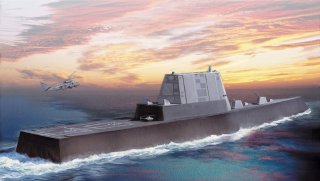Weapons of the Future: DDG Next Will Have Lasers, Rail Guns, and Missiles
While they feature improved radars, questions have been raised about the survivability of a late 1980s ship design against modern naval threats, in particular increasingly lethal stand-off missiles.
Here's What You Need to Remember: The new class of ship, for now provisionally called the DDG Next, would fall somewhere in-between the 9,000 ton Arleigh Burke and the 16,000 ton Zumwalt-class.
The U.S. Navy’s Chief of Naval Operations Adm. Mike Gilday outlined what he would like to see come out of American shipyards. Ideally the new ships would be able to pack more anti-ship missiles onboard than the Navy’s Arleigh Burke guided-missile destroyers are able to carry, and wouldn’t be as large as the stealthy 610-foot Zumwalt-class guided missile destroyers.
Adm. Gilday was unequivocal. “I need deeper magazines,” he stated.
The new class of ship, for now provisionally called the DDG Next, would fall somewhere in-between the 9,000 ton Arleigh Burke and the 16,000 ton Zumwalt-class. “I don’t want to build a monstrosity,” Adm. Gilday explained. “When you talk about large surface combatants, people in their mind’s eye are thinking battleships. That’s not what I’m talking about. That’s not where we’re going.”
In addition to the new class’ more compact size, the Navy is hopeful that directed energy weapons—lasers or railguns—will have a place onboard. Though the technology is not yet mature, the Navy has high hopes for directed energy weapons which they anticipate will drastically increase ship survivability—if the energy-intensive weapons can be successfully mated to ships.
In anticipation of the high energy requirements directed energy weapons would require, the Navy may move to integrate a high-output electrical power system onboard. One solution could be the Zumwalt-class’ Integrated Power System that converts mechanical energy to electrical energy in order to power onboard electronics.
A 355 Ship Navy
China recently surpassed the United States Navy as the world’s largest. In an effort to mitigate the imbalance and threat posed by a large Chinese Navy, the United States Navy would like to increase the number of ships available.
The Zumwalt-class was supposed to be thirty-two hulls in total, though due to astronomical cost overruns, the class was ultimately limited to only three hulls. This has led to an increased reliance on the Navy’s late-Cold War era Arleigh Burke-class guided missile destroyers.
Though capable when first introduced in the early 1990s, the class has grown somewhat long in the tooth. The most advanced of the Arleigh Burke-class, the DDG Flight IIIs are still being built today. While they feature improved radars, questions have been raised about the survivability of a late 1980s ship design against modern naval threats, in particular increasingly lethal stand-off missiles. One of the class’ additional limitations is an inadequate amount of electrical power generation for the Navy’s future weapons, be they railguns or lasers.
Postscript
Much remains to be seen about the DDG Next class. Regardless of what they’re armed with— conventional weapon systems or directed-energy weapons—we’ll have the latest information once it is available. Watch this topic for future information in the future.
Caleb Larson is a Defense Writer with The National Interest. He holds a Master of Public Policy and covers U.S. and Russian security, European defense issues, and German politics and culture.
Image: Reuters

